ISON, not a comet
Recently, when I saw on Habré an article about the comet C / 2012 S1 (ISON), which is now flying past the Sun, I suddenly smashed the search request "ISON" into the search, but I did not find anything except the comet. He repeated the operation on Yandyks: the result was almost the same, only the official website at the end of the second page. To my surprise, there was no limit. After all, ISON is not just the name of a comet. This is the name of a huge network built by Russian scientists over the past decade. One of the few successful examples of the merging of world-class science and high technology in modern Russia. And the discovery of this comet is only a natural consequence of the network.
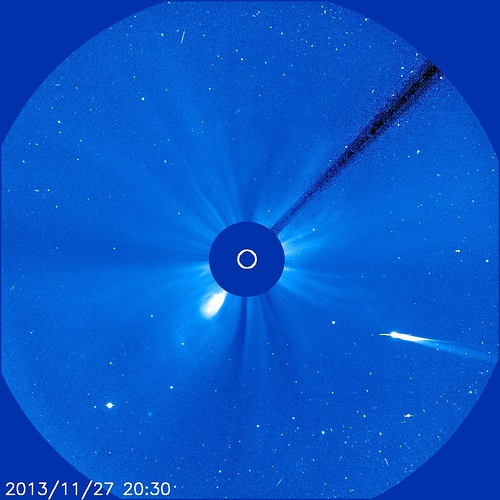
I myself have a very remote attitude to this project, but I know many people participating in it. For the last six years I have been observing its development at the edge of my eye, mainly under articles in various journals and at conferences. This story does not pretend to be complete, everything written is an outside view. As far as I know, on Habré decently astronomers. Maybe someone will add something, or write his article.
ISON is a project in which a large network of telescopes is deployed around the world to observe satellites, asteroids and comets. Telescopes in the network automatically observe objects from the solar system, in addition, they carry out a lot of scientific work, for example, the detection of gamma-ray bursts. ISON is an international name, in Russian the project is called “Pulkovo cooperation of optical observers”. And now in order.

After the collapse of the Union, science became useless to anyone and was funded on a residual basis. First of all, those areas of science that demanded massive investments suffered. Astronomy, which cannot even predict where to dig another well for oil extraction, was primarily affected. The situation was aggravated by the fact that most telescopes in the Union were located outside Russia, in countries such as Tajikistan and Uzbekistan. There is little rain and good astroclimate. After the collapse, it became much harder to get to them, and the state-owners wanted money for their use.
Everything could have gone less painfully, but in the 90s there was a huge technological leap: CCD cameras and robotized control of telescope drives appeared. The old observatories have become bulky. The productivity and efficiency of the refurbished observatory increased many times, while reducing the number of personnel. Today, a large observatory can be serviced by a shift of 2 people. Tasks for observation are discarded remotely and are monitored automatically.
Reading and listening to stories about those times, it seems that almost all astronomy in the 90s was lost. The number of observatories has decreased, huge telescopes stood idle, occasionally making separate observations on the single remaining photographic plates that no one ever produced.
But one topic, which became relevant in 2001, managed to feed many. Roscosmos realized that its capacity for observing artificial earth satellites is sorely lacking. If you take the American satellite catalog NORAD and draw how many satellites fly from it at different distances, you get this picture:
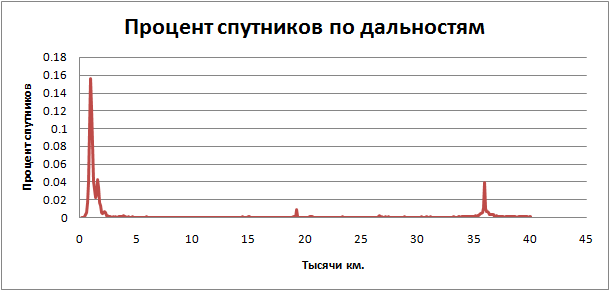

In the first peak is the absolute majority of satellites (mainly cartographic and research). Peak at 20 thousand - navigation systems. At 36 thousand - geostationaries. Radars located on Earth, see objects that fly not very far, somewhere up to 2-3 thousand kilometers (the reflected radiation is proportional to the distance to the fourth degree). There is also the legendary Window . But his power is not enough to control all the satellites remaining after the radar. A geostationary orbit is one of the most populated orbits in the world. There are flying satellites, the price of which can be equal to the budget of a small country. Next to them, along unstable trajectories, pieces of garbage and spent satellites are scurrying around.
To solve this problem, the remnants of the astronomical community received a grant to create a network of monitoring geostationaries. And, most surprisingly, the grant went to the people who spent it not just on writing reports and creating samples, but on restoring the observatories. Often worked only on enthusiasm.
On the project website they write that the basis was:
In reality, this meant that any observatory ready to participate in the project could receive a modern camera and mount for free. Considering that the cost of a good astrocamera, a simple telescope and a mount is approaching a million rubles - many have grabbed the opportunity. Observatories required one - half of starry nights to turn on the system for satellite observations (I do not know the contract terms more precisely, but I suspect that the observers were paying something extra). The observatories spent the second half of the starry nights on their own research using the latest equipment.
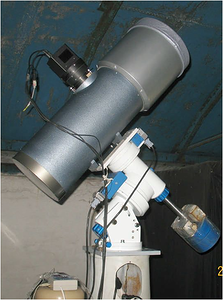

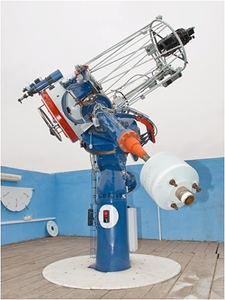
The grants network only existed for the first years. And then it went on self-sufficiency, selling measurements on satellites. As far as I know, the entire income from the observations went into the development of the project and the installation of new telescopes (now, perhaps, something has already changed, but it is unlikely). Due to this, many observatories received modern telescopes, which made it possible for hundreds of astronomers in our country and the former CIS to do research. Judging by the latest reports at conferences, today the network includes 33 observatories around the world with 70 telescopes in 14 countries of the world. This whole farm looks like this:
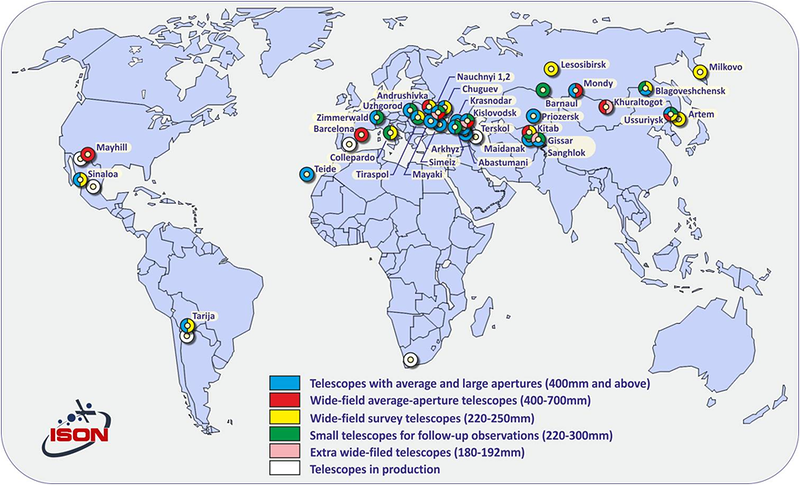
Here is a map in more detail.
As far as I know, now the ISON network maintains the most complete base of geostationary objects in the world. In one of the reports there were figures that ISON currently supports about 1,800 objects in geostationary orbits, 600 of which even the American control system does not observe.
The second direction of the network is the observation of asteroids and comets. A lot of the equipment that is used to observe satellites can be used to observe asteroids. In addition, it is easier to place a new instrument in the observatory, where there is already infrastructure. After the fall of the Chelyabinsk meteorite, interest in the topic jumped sharply, although the main work of the network was built even before this event. Actually, the flying comet C / 2012 S1 (ISON) was discovered about a year ago in the Kislovodsk Observatory of the project by Vitaly Nevsky and Artyom Novichonk. Today, the top 30 most productive observatories in the world are three of the project’s 7 observatories that deal with asteroid-comet hazard.

As an outsider, I find it difficult to describe ISON in full detail. I can only mention that within its framework there is an observatory built from scratch, that in addition to observations of satellites and comets, there are observations of gamma-ray bursts, when detected, all telescopes of the network are coordinated. On the basis of the telescopes of the project, studies are conducted in universities, and not only in Russia and the CIS countries.
Those who are interested, I think, will be curious to read the site creators of ISON. There are many different articles and stories about the device, the creation and development of the project.

I myself have a very remote attitude to this project, but I know many people participating in it. For the last six years I have been observing its development at the edge of my eye, mainly under articles in various journals and at conferences. This story does not pretend to be complete, everything written is an outside view. As far as I know, on Habré decently astronomers. Maybe someone will add something, or write his article.
ISON is a project in which a large network of telescopes is deployed around the world to observe satellites, asteroids and comets. Telescopes in the network automatically observe objects from the solar system, in addition, they carry out a lot of scientific work, for example, the detection of gamma-ray bursts. ISON is an international name, in Russian the project is called “Pulkovo cooperation of optical observers”. And now in order.

After the collapse of the Union, science became useless to anyone and was funded on a residual basis. First of all, those areas of science that demanded massive investments suffered. Astronomy, which cannot even predict where to dig another well for oil extraction, was primarily affected. The situation was aggravated by the fact that most telescopes in the Union were located outside Russia, in countries such as Tajikistan and Uzbekistan. There is little rain and good astroclimate. After the collapse, it became much harder to get to them, and the state-owners wanted money for their use.
Everything could have gone less painfully, but in the 90s there was a huge technological leap: CCD cameras and robotized control of telescope drives appeared. The old observatories have become bulky. The productivity and efficiency of the refurbished observatory increased many times, while reducing the number of personnel. Today, a large observatory can be serviced by a shift of 2 people. Tasks for observation are discarded remotely and are monitored automatically.
Reading and listening to stories about those times, it seems that almost all astronomy in the 90s was lost. The number of observatories has decreased, huge telescopes stood idle, occasionally making separate observations on the single remaining photographic plates that no one ever produced.
But one topic, which became relevant in 2001, managed to feed many. Roscosmos realized that its capacity for observing artificial earth satellites is sorely lacking. If you take the American satellite catalog NORAD and draw how many satellites fly from it at different distances, you get this picture:


In the first peak is the absolute majority of satellites (mainly cartographic and research). Peak at 20 thousand - navigation systems. At 36 thousand - geostationaries. Radars located on Earth, see objects that fly not very far, somewhere up to 2-3 thousand kilometers (the reflected radiation is proportional to the distance to the fourth degree). There is also the legendary Window . But his power is not enough to control all the satellites remaining after the radar. A geostationary orbit is one of the most populated orbits in the world. There are flying satellites, the price of which can be equal to the budget of a small country. Next to them, along unstable trajectories, pieces of garbage and spent satellites are scurrying around.
To solve this problem, the remnants of the astronomical community received a grant to create a network of monitoring geostationaries. And, most surprisingly, the grant went to the people who spent it not just on writing reports and creating samples, but on restoring the observatories. Often worked only on enthusiasm.
On the project website they write that the basis was:
- Support of astronomers and equipping modern observatories of the former USSR
- Preservation and modernization of existing telescopes in the CIS countries
- Involving astronomy enthusiasts and creating new observation points;
- Organization of long-term cooperation of self-financing observatories
- The solution of scientific and applied problems requiring the participation of a distributed observational network
In reality, this meant that any observatory ready to participate in the project could receive a modern camera and mount for free. Considering that the cost of a good astrocamera, a simple telescope and a mount is approaching a million rubles - many have grabbed the opportunity. Observatories required one - half of starry nights to turn on the system for satellite observations (I do not know the contract terms more precisely, but I suspect that the observers were paying something extra). The observatories spent the second half of the starry nights on their own research using the latest equipment.



The grants network only existed for the first years. And then it went on self-sufficiency, selling measurements on satellites. As far as I know, the entire income from the observations went into the development of the project and the installation of new telescopes (now, perhaps, something has already changed, but it is unlikely). Due to this, many observatories received modern telescopes, which made it possible for hundreds of astronomers in our country and the former CIS to do research. Judging by the latest reports at conferences, today the network includes 33 observatories around the world with 70 telescopes in 14 countries of the world. This whole farm looks like this:

Here is a map in more detail.
As far as I know, now the ISON network maintains the most complete base of geostationary objects in the world. In one of the reports there were figures that ISON currently supports about 1,800 objects in geostationary orbits, 600 of which even the American control system does not observe.
The second direction of the network is the observation of asteroids and comets. A lot of the equipment that is used to observe satellites can be used to observe asteroids. In addition, it is easier to place a new instrument in the observatory, where there is already infrastructure. After the fall of the Chelyabinsk meteorite, interest in the topic jumped sharply, although the main work of the network was built even before this event. Actually, the flying comet C / 2012 S1 (ISON) was discovered about a year ago in the Kislovodsk Observatory of the project by Vitaly Nevsky and Artyom Novichonk. Today, the top 30 most productive observatories in the world are three of the project’s 7 observatories that deal with asteroid-comet hazard.

As an outsider, I find it difficult to describe ISON in full detail. I can only mention that within its framework there is an observatory built from scratch, that in addition to observations of satellites and comets, there are observations of gamma-ray bursts, when detected, all telescopes of the network are coordinated. On the basis of the telescopes of the project, studies are conducted in universities, and not only in Russia and the CIS countries.
Those who are interested, I think, will be curious to read the site creators of ISON. There are many different articles and stories about the device, the creation and development of the project.
')
Source: https://habr.com/ru/post/203940/
All Articles